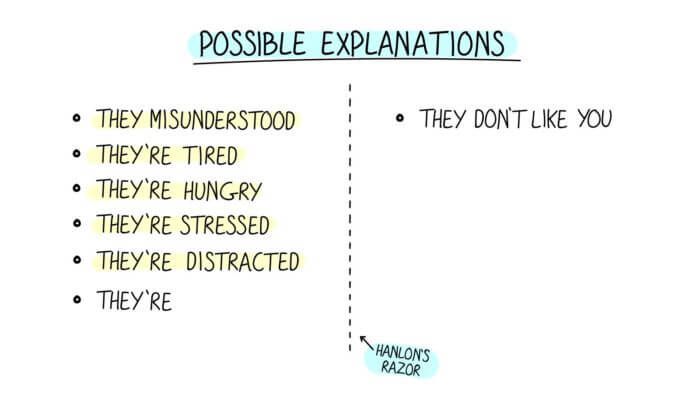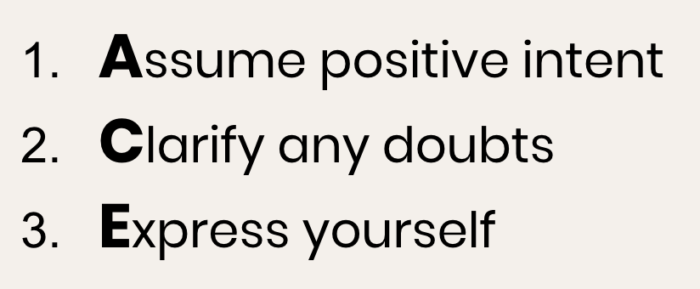
Working across land and sea: Tips for remote communication
Main illustration: Joshuah Miranda
For remote workers, chat is the simplest option for communication. But if most communication is nonverbal, how do you make sure what you say and hear aren’t misinterpreted?
When speaking with someone in person, the words you use matter. But if there’s any ambiguity in what you’re trying to say or how you feel about a situation, those nonverbal factors – such as body language, facial expression, etc. – have a greater impact than the words you use.
I’ve learned this time and time again as a remote worker of nearly seven years, and I’m proud to say I’ve developed strong and effective working relationships with my teammates here at Intercom even without meeting most of them in person. Here are three tips – A.C.E. for the acronym-minded – for effective remote communication:
1. Assume positive intent

Source: Matthew Cook
If your words aren’t clear, then the recipient is left filling in the blanks with assumptions. Those assumptions not only derail whatever you’re working on, but it can have a more lasting impact on the way your teammates perceive you, and vice versa.
I know it’s easy to say pause and breathe, but really… Pause. Breathe. If you read a message that seems negative in any way, give yourself a minute to respond and short circuit any swirl happening in your mind. Realistically, it’s highly likely there wasn’t any negative intent at all.
During this pause, consider other explanations for what was just said. Here I like to draw on Hanlon’s Razor, which basically says “Never attribute to malice that which is adequately explained by ignorance.” In distance communication, there are a host of reasons why someone might have come across negatively that have nothing to do with you: hanger, distraction, stress… We can all relate to these, right?!
2. Clarify ambiguity
If we think of chat as a proxy for speaking, the onus is always on the speaker to make themselves understood. It never hurts to overcommunicate or overclarify online.
An obvious example is acronyms. These rarely translate well online, particularly when chatting cross-functionally. If you must use one, always spell out the first instance. Especially with someone you don’t know well, and especially with someone who isn’t in your timezone. Nothing drains a conversation of energy faster than when someone has to wait 12 hours to clarify an acronym.
On the flipside, if you’re unclear about something, ask! In real life when someone says something that’s left you scratching your head, you’d clear it up quickly. It probably happens hundreds of times a day, and you don’t even think about it.
Make this a habit online as well. It could be as simple as saying: “I’m working on my distance communication, and I wanna make sure that I get you” or rephrasing and returning, like “Just so we’re clear, what you’re saying is…” or bluntly, “It’s not clear from your message how you feel about this.” Yes, it’s direct, but it’ll nip any confusion in the bud and get your conversation back into a productive, healthy place.
Personally, I like to pair it with an emoji or two to soften the clarification on Slack.
3. Express yourself
At the end of the day, communication isn’t just getting information from A to B. It’s how we actually connect and build relationships, something that happens so naturally in an office and less so via chat.
So let’s express ourselves online better! A great start is to explore the >3,000 standard emoji available on most messaging platforms.
“As a remote worker, I’m begging you to stop using this emoji: 🙂”
And as a remote worker, I’m begging you to stop using this emoji: 🙂. You may think this smile shows you’re happy, but it’s the easiest to misinterpret as negative to someone who doesn’t know you well. It might come across as passive aggressive, sarcastic, unimpressed, etc. It’s not particularly representative of a real human smile either (try making that face– feels fake, right?) so it’s a poor proxy for expressing genuine happiness. We have a bevy of clearer expressions to choose from:

As my teammate Jen noted, we can also use non-standard punctuation and text formatting to mimic our voice and tone. Note the differences between:
Sure!!!
vs
Sure…
We can also use phonetic spelling and letter repetition to reflect the inflections in our voice:
Sooooooo good!
Oooooh wow
Aha!
WHAT! (using all caps to indicate shouting)
That’s highly unlikely (using italics to indicate tone of emphasis)
There’s plenty to explore. I’d encourage you all to play with this a bit.
Being personal across land and sea
Remote work may seem fun and easy, but we’re uniquely challenged by the lack of nonverbal cues at our disposal. To communicate effectively, follow these principles and make them a habit to help you ACE your distance communication and build strong, lasting online relationships.









